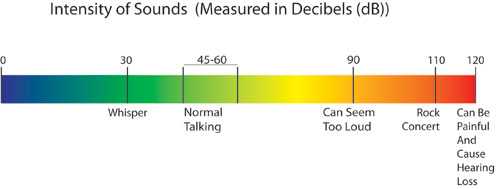About Sound
In order to understand hearing loss, it helps to understand how we hear. Sounds are described in terms of their frequency, known as “pitch,” and intensity, known as “loudness.”
Sound Frequency (Pitch)
Frequency is measured in hertz (Hz). A person who has hearing within the normal range can hear sounds that have frequencies between 20 and 20,000 Hz. The most important sounds we hear every day are in the 250 to 6,000 Hz range.
Speech includes a mix of low and high frequency sounds:
- Vowel sounds like a short “o” as in the word “hot,” have low frequencies (250 to 1,000 Hz) and are usually easier to hear.
- Consonants like “s,” “h,” and “f,” have higher frequencies (1,500 to 6,000 Hz) and are harder to hear. Consonants convey most of the meaning of what we say. Someone who cannot hear high-frequency sounds will have a hard time understanding speech and language.

Sound Intensity (Loudness)
Sound intensity, or loudness, is measured in decibels (dB).
- A person with hearing within the normal range can hear sounds ranging from 0 to 140 dB.
- A whisper is around 25 to 30 dB.
- Conversations are usually 45 to 60 dB.
- Sounds that are louder than 90 dB can be uncomfortable to hear.
- A loud rock concert might be as loud as 110 dB.
- Sounds that are 120 dB or louder can be painful and can result in temporary or permanent hearing loss.

Different groups and organizations use decibels to define the degree of hearing loss differently. Click on the following links to see some examples:
American Speech-Language-Hearing Association
Boys Town National Research Hospital
- Page last reviewed: July 24, 2015
- Page last updated: July 24, 2015
- Content source:



 ShareCompartir
ShareCompartir